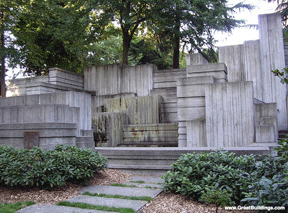 |
| Halprin's Freeway Park, Seattle, WA |
| KATE
JAMES |
MIT
4.213J/11.308J URBAN NATURE AND CITY DESIGN |
| - - - > THE SCORE IN DESIGN PRACTICE |
| - - - > HOME |
| - - - > BACKGROUND |
| - - - > DESIGNING THE SCORE |
| - - - > EXAMPLE- SCORE PERFORMED BY CLASS |
| - - - > CLASS HOME |
It is difficult to pinpoint the design steps that scoring would fulfill. Scores are a site study process, but don't result in a database of quantifications or information sets. Because of the fluidity and experiential nature of the results, these results would seem to bleed from site research into design itself, occupying parts of both of these normally discrete steps of planning. Within the score itself, responses begin as more direct responses to the inquiries provided and eventually gather momentum to extend beyond the score directions to clear assignments of values to the site. This full spectrum of knowledge- from less calculated, more viceral response to evaluation of perceptions, can feed directly into a designer's synthesized response.
It
was also suggested by the class that scores may be especially useful in evaluating
the success of already designed/developed sites. In this post-design use,
scoring would seem to feed into a larger design scope, providing feedback
information to designers and revealing successes and failures of planning--
lessons to be carried to further design practice.
 |
| Halprin's Freeway Park, Seattle, WA |